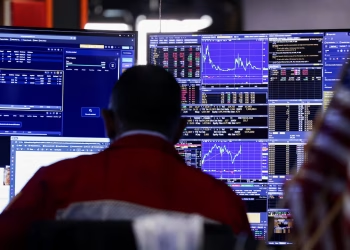Traders work on the floor of the New York Stock Exchange (NYSE) in New York, United States, October 16, 2025.
Jeenah Moon | Reuters
U.S. stock futures were slightly lower Thursday evening after the previous session saw a selloff fueled by concerns about regional banks’ lending practices.
Futures contracts linked to the Dow Jones Industrial Average slipped 153 points, or 0.33%. S&P Futures And Nasdaq 100 Futures both fell more than 0.5%.
In after-hours trading, Interactive Brokers Group fell more than 2% despite reporting strong quarterly results, and Oracle slipped more than 2% after the cloud computing giant gave analysts its long-term financial outlook. Drug manufacturers Elie Lilly And Novo Nordisk also fell after President Donald Trump, during a briefing on fertility treatments, suggested the administration was negotiating much lower prices for its blockbuster obesity drugs.
Each of the main US stock indexes closed in the red on Wednesday, fueled by a significant drop in banking stocks at the end of the session. The Dow Jones lost 301.07 points, or 0.7%, while the S&P 500 and the Nasdaq Composite stabilized by 0.6% and 0.5%, respectively.
Shares of several financial heavyweights and regional banking names fell after Sions and Western Alliance disclosed bad loans, sparking concerns about lax lending practices and fears similar problems could arise. The SPDR S&P Regional Banking ETF (KRE), down for four straight weeks, lost more than 6% during the session. Concern in the banking sector has increased following the recent bankruptcies of two companies linked to the automobile industry.
Friday will provide another opportunity to assess the state of regional banks, with a large number of companies set to report results, including Comerica And Fifth thirdamong others.
Wednesday also saw an increase in Cboe Volatility Indexcommonly referred to as the Wall Street Fear Indicator, alongside falling Treasury and US dollar yields. In contrast, gold prices hit new records, suggesting continued interest in this safe haven amid widespread uncertainty.
Liz Ann Sonders, chief investment strategist at Charles Schwab, said Wednesday on CNBC’s “Closing Bell” that the banking concerns come as there is a lot of “speculative froth” that has developed in the public market, with investors seeking stocks with riskier profiles like quantum computing, drones and unprofitable technology stocks.
“When you have this speculative froth and then you have sort of a broader potential problem, those two can sometimes collide and cause an increase in volatility,” she said, noting that most of the so-called froth is no longer in mega-cap names, but rather in smaller pockets of the market such as Russell 2000 Indexwhich reached a new high on Wednesday.
At the same time, tensions over global trade and tariff policies, high stock market valuations amid an artificial intelligence boom, and the effects of the current U.S. government shutdown have also continued unabated. The shutdown, now in its third week, has led to an indefinite halt to the release of crucial economic data by federal agencies.
This week, the S&P500 is up almost 1.2%, with good start to the third quarter results supporting stocks. Stock of 30 Dow Jones Industrial Average has added about 1% since the start of the week, while the Nasdaq Composite gained 1.6%.









